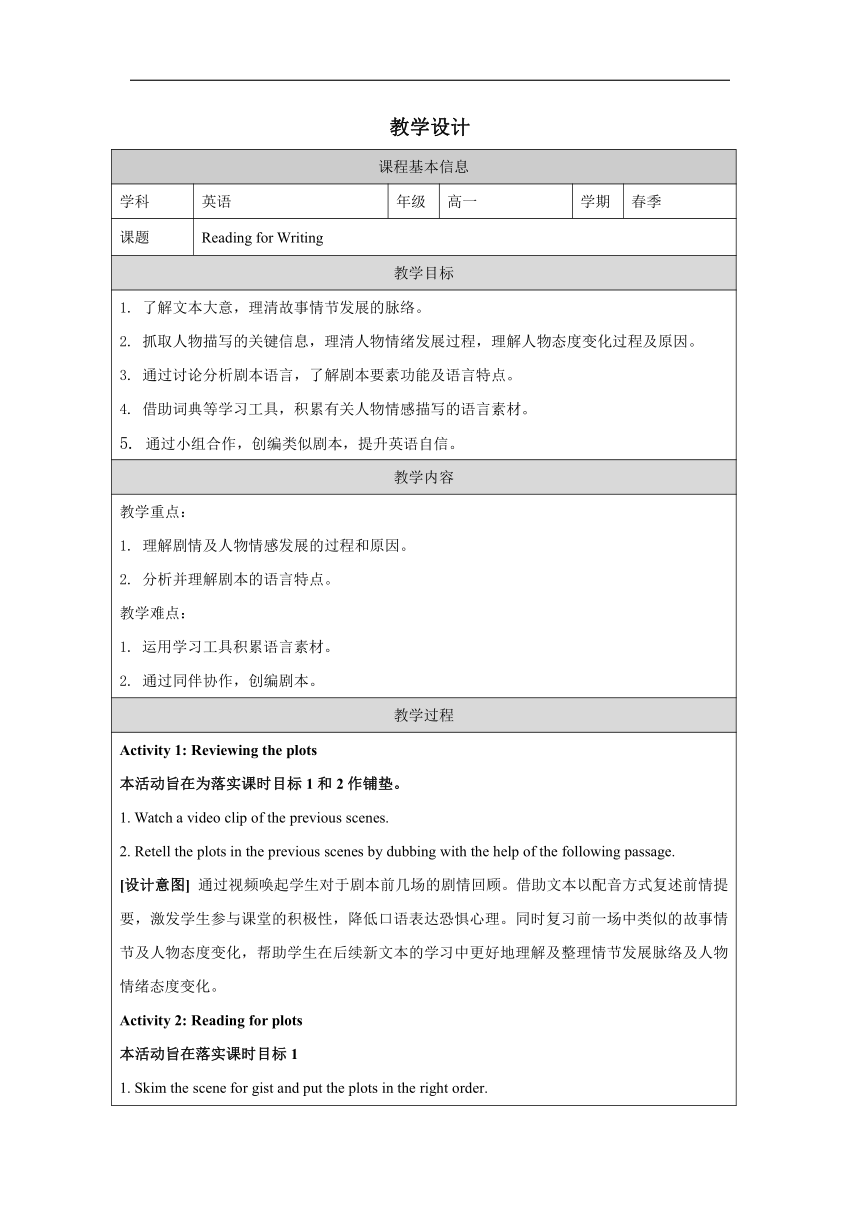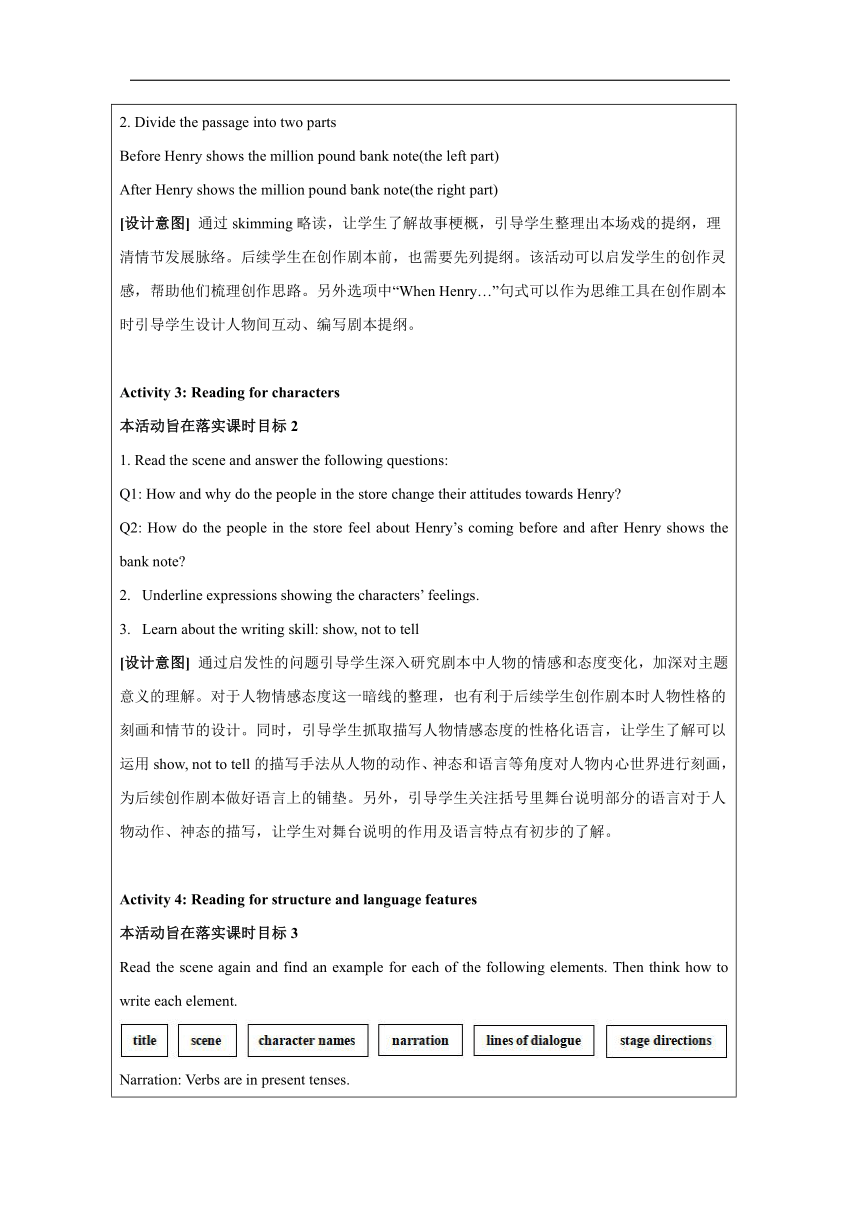人教版(2019)必修第三册 Unit 5 The Value of Money Reading for Writing-教学设计(表格式)
文档属性
| 名称 | 人教版(2019)必修第三册 Unit 5 The Value of Money Reading for Writing-教学设计(表格式) |

|
|
| 格式 | docx | ||
| 文件大小 | 27.5KB | ||
| 资源类型 | 教案 | ||
| 版本资源 | 人教版(2019) | ||
| 科目 | 英语 | ||
| 更新时间 | 2024-04-05 04:38:53 | ||
图片预览


文档简介
教学设计
课程基本信息
学科 英语 年级 高一 学期 春季
课题 Reading for Writing
教学目标
了解文本大意,理清故事情节发展的脉络。 抓取人物描写的关键信息,理清人物情绪发展过程,理解人物态度变化过程及原因。 通过讨论分析剧本语言,了解剧本要素功能及语言特点。 借助词典等学习工具,积累有关人物情感描写的语言素材。 通过小组合作,创编类似剧本,提升英语自信。
教学内容
教学重点: 理解剧情及人物情感发展的过程和原因。
2. 分析并理解剧本的语言特点。
教学难点: 运用学习工具积累语言素材。
2. 通过同伴协作,创编剧本。
教学过程
Activity 1: Reviewing the plots 本活动旨在为落实课时目标1和2作铺垫。 1. Watch a video clip of the previous scenes. 2. Retell the plots in the previous scenes by dubbing with the help of the following passage. [设计意图] 通过视频唤起学生对于剧本前几场的剧情回顾。借助文本以配音方式复述前情提要,激发学生参与课堂的积极性,降低口语表达恐惧心理。同时复习前一场中类似的故事情节及人物态度变化,帮助学生在后续新文本的学习中更好地理解及整理情节发展脉络及人物情绪态度变化。 Activity 2: Reading for plots 本活动旨在落实课时目标1 1. Skim the scene for gist and put the plots in the right order. 2. Divide the passage into two parts Before Henry shows the million pound bank note(the left part) After Henry shows the million pound bank note(the right part) [设计意图] 通过skimming略读,让学生了解故事梗概,引导学生整理出本场戏的提纲,理清情节发展脉络。后续学生在创作剧本前,也需要先列提纲。该活动可以启发学生的创作灵感,帮助他们梳理创作思路。另外选项中“When Henry…”句式可以作为思维工具在创作剧本时引导学生设计人物间互动、编写剧本提纲。 Activity 3: Reading for characters 本活动旨在落实课时目标2 1. Read the scene and answer the following questions: Q1: How and why do the people in the store change their attitudes towards Henry Q2: How do the people in the store feel about Henry’s coming before and after Henry shows the bank note Underline expressions showing the characters’ feelings. Learn about the writing skill: show, not to tell [设计意图] 通过启发性的问题引导学生深入研究剧本中人物的情感和态度变化,加深对主题意义的理解。对于人物情感态度这一暗线的整理,也有利于后续学生创作剧本时人物性格的刻画和情节的设计。同时,引导学生抓取描写人物情感态度的性格化语言,让学生了解可以运用show, not to tell的描写手法从人物的动作、神态和语言等角度对人物内心世界进行刻画,为后续创作剧本做好语言上的铺垫。另外,引导学生关注括号里舞台说明部分的语言对于人物动作、神态的描写,让学生对舞台说明的作用及语言特点有初步的了解。 Activity 4: Reading for structure and language features 本活动旨在落实课时目标3 Read the scene again and find an example for each of the following elements. Then think how to write each element. Narration: Verbs are in present tenses. Lines of dialogue: Use request to show politeness, command rudeness. Stage directions: Complete sentences, present participle or prepositional phrases can be used. Words are usually in italics. [设计意图] 通过同伴讨论,让学生初步了解剧本六要素的语言特点。通过节选六要素的代表性语言,用启发性问题引导学生深入研究各要素的功能及语言特点,为后续自主创编完整的剧本打下坚实的语言基础。 Activity5 language building 本活动旨在落实课时目标 Use the writing skill: show, not to tell. ① decide a feeling you want to show ② think what your body will do with the feeling Use dictionaries to find more expressions to show shock as an example. [设计意图] 通过写作技巧的学法指导及词典的辅助应用,帮助学生拓宽学习渠道,获取更多语言素材,为后续学生自主创编剧本奠定良好的语言基础。 Activity 6: Writing 本活动旨在落实课时目标5 Brainstorm the places Henry will go to, and what difficulties he might face. Work in groups and create a new scene according to the following step: Make a list of the characters. Make an outline of the events in the scene. Decide how the characters’ feelings change during the scene. Think of an exciting ending. Write the dialogue. Write the stage directions. [设计意图]通过头脑风暴,发散学生思维,让学生根据自己的具体情况,以小组为单位,选择自己喜欢的场景,以阅读部分所总结的情节提纲为结构和内容支架,以文本中可借鉴的人物对话、电子词典语言素材以及戏剧六要素的语言特点为语言支架,进行剧本创编。小组合作写作,可以集思广益,充分体现每个成员的智慧,降低学生的写作焦虑。让学生在与同伴的交流中获得启发,互相学习,也有助于对学生合作能力的培养。 Assignment: Use the checklist to revise the draft. Are all the elements of a play included and in good order Do the characters use suitable language Are the stage directions clear and useful Is the plot clear and exciting enough Are there any grammar, spelling, or punctuation errors Draw a poster for the scene. Role play the scene. [设计意图]学生以小组为单位,根据所提供的评价标准核查剧本的内容及形式,一起探讨剧本。教师课后了解各组完成情况,及时地给予个性化的指导。学生根据教师的建议修改和完善剧本后,以短剧的形式分角色表演展示。最后,以生生评价,师生评价等多元化方式对表演进行点评。评价量规的使用可以让促进学生进一步内化剧本这一特殊文体的结构特征和语言特点。多元化的评价方式能够最大程度激发学生的参与热情,同时也有助于教师衡量不同层次的同学对于教学内容的掌握程度,从而调整后续的教学计划。
课程基本信息
学科 英语 年级 高一 学期 春季
课题 Reading for Writing
教学目标
了解文本大意,理清故事情节发展的脉络。 抓取人物描写的关键信息,理清人物情绪发展过程,理解人物态度变化过程及原因。 通过讨论分析剧本语言,了解剧本要素功能及语言特点。 借助词典等学习工具,积累有关人物情感描写的语言素材。 通过小组合作,创编类似剧本,提升英语自信。
教学内容
教学重点: 理解剧情及人物情感发展的过程和原因。
2. 分析并理解剧本的语言特点。
教学难点: 运用学习工具积累语言素材。
2. 通过同伴协作,创编剧本。
教学过程
Activity 1: Reviewing the plots 本活动旨在为落实课时目标1和2作铺垫。 1. Watch a video clip of the previous scenes. 2. Retell the plots in the previous scenes by dubbing with the help of the following passage. [设计意图] 通过视频唤起学生对于剧本前几场的剧情回顾。借助文本以配音方式复述前情提要,激发学生参与课堂的积极性,降低口语表达恐惧心理。同时复习前一场中类似的故事情节及人物态度变化,帮助学生在后续新文本的学习中更好地理解及整理情节发展脉络及人物情绪态度变化。 Activity 2: Reading for plots 本活动旨在落实课时目标1 1. Skim the scene for gist and put the plots in the right order. 2. Divide the passage into two parts Before Henry shows the million pound bank note(the left part) After Henry shows the million pound bank note(the right part) [设计意图] 通过skimming略读,让学生了解故事梗概,引导学生整理出本场戏的提纲,理清情节发展脉络。后续学生在创作剧本前,也需要先列提纲。该活动可以启发学生的创作灵感,帮助他们梳理创作思路。另外选项中“When Henry…”句式可以作为思维工具在创作剧本时引导学生设计人物间互动、编写剧本提纲。 Activity 3: Reading for characters 本活动旨在落实课时目标2 1. Read the scene and answer the following questions: Q1: How and why do the people in the store change their attitudes towards Henry Q2: How do the people in the store feel about Henry’s coming before and after Henry shows the bank note Underline expressions showing the characters’ feelings. Learn about the writing skill: show, not to tell [设计意图] 通过启发性的问题引导学生深入研究剧本中人物的情感和态度变化,加深对主题意义的理解。对于人物情感态度这一暗线的整理,也有利于后续学生创作剧本时人物性格的刻画和情节的设计。同时,引导学生抓取描写人物情感态度的性格化语言,让学生了解可以运用show, not to tell的描写手法从人物的动作、神态和语言等角度对人物内心世界进行刻画,为后续创作剧本做好语言上的铺垫。另外,引导学生关注括号里舞台说明部分的语言对于人物动作、神态的描写,让学生对舞台说明的作用及语言特点有初步的了解。 Activity 4: Reading for structure and language features 本活动旨在落实课时目标3 Read the scene again and find an example for each of the following elements. Then think how to write each element. Narration: Verbs are in present tenses. Lines of dialogue: Use request to show politeness, command rudeness. Stage directions: Complete sentences, present participle or prepositional phrases can be used. Words are usually in italics. [设计意图] 通过同伴讨论,让学生初步了解剧本六要素的语言特点。通过节选六要素的代表性语言,用启发性问题引导学生深入研究各要素的功能及语言特点,为后续自主创编完整的剧本打下坚实的语言基础。 Activity5 language building 本活动旨在落实课时目标 Use the writing skill: show, not to tell. ① decide a feeling you want to show ② think what your body will do with the feeling Use dictionaries to find more expressions to show shock as an example. [设计意图] 通过写作技巧的学法指导及词典的辅助应用,帮助学生拓宽学习渠道,获取更多语言素材,为后续学生自主创编剧本奠定良好的语言基础。 Activity 6: Writing 本活动旨在落实课时目标5 Brainstorm the places Henry will go to, and what difficulties he might face. Work in groups and create a new scene according to the following step: Make a list of the characters. Make an outline of the events in the scene. Decide how the characters’ feelings change during the scene. Think of an exciting ending. Write the dialogue. Write the stage directions. [设计意图]通过头脑风暴,发散学生思维,让学生根据自己的具体情况,以小组为单位,选择自己喜欢的场景,以阅读部分所总结的情节提纲为结构和内容支架,以文本中可借鉴的人物对话、电子词典语言素材以及戏剧六要素的语言特点为语言支架,进行剧本创编。小组合作写作,可以集思广益,充分体现每个成员的智慧,降低学生的写作焦虑。让学生在与同伴的交流中获得启发,互相学习,也有助于对学生合作能力的培养。 Assignment: Use the checklist to revise the draft. Are all the elements of a play included and in good order Do the characters use suitable language Are the stage directions clear and useful Is the plot clear and exciting enough Are there any grammar, spelling, or punctuation errors Draw a poster for the scene. Role play the scene. [设计意图]学生以小组为单位,根据所提供的评价标准核查剧本的内容及形式,一起探讨剧本。教师课后了解各组完成情况,及时地给予个性化的指导。学生根据教师的建议修改和完善剧本后,以短剧的形式分角色表演展示。最后,以生生评价,师生评价等多元化方式对表演进行点评。评价量规的使用可以让促进学生进一步内化剧本这一特殊文体的结构特征和语言特点。多元化的评价方式能够最大程度激发学生的参与热情,同时也有助于教师衡量不同层次的同学对于教学内容的掌握程度,从而调整后续的教学计划。
